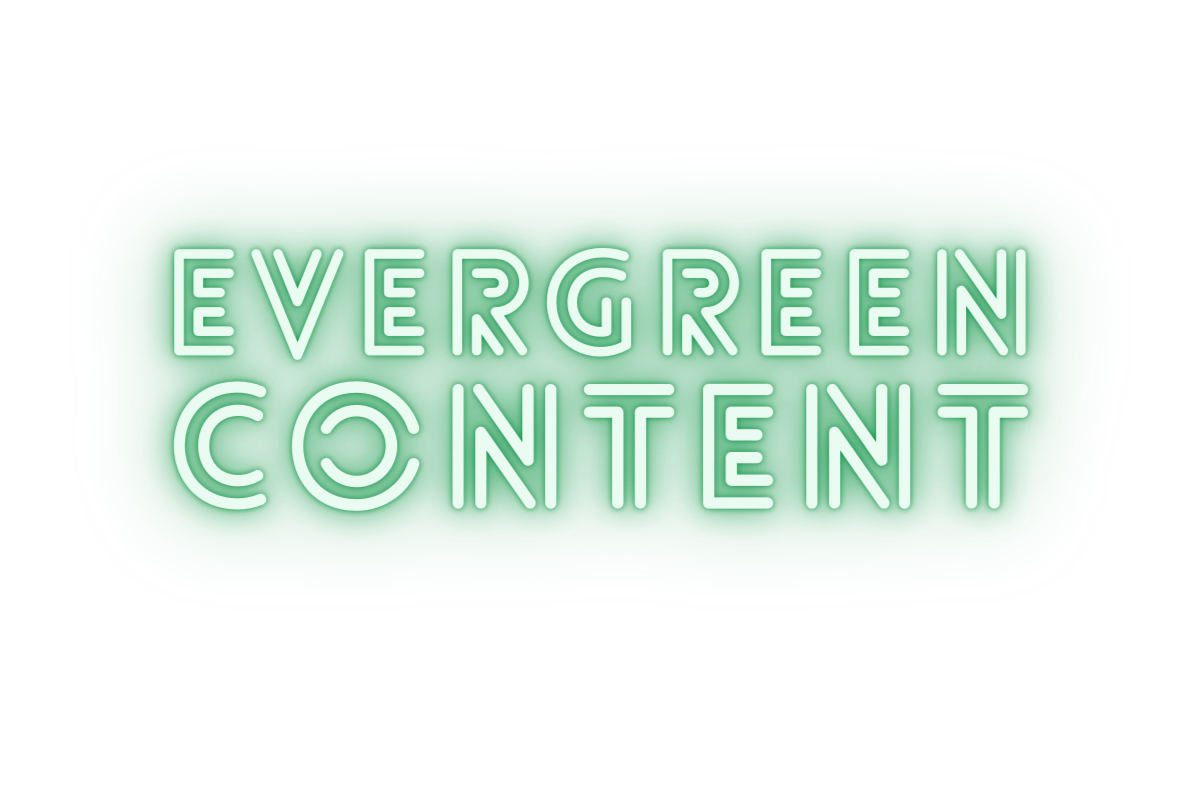Table of contents
Czytasz teraz:
Evergreen Content – The Holy Grail of Content Marketing Strategy
Close
The lifespan of digital content is usually very short. And by digital content, I don’t mean necessarily social media, and formats such as Stories, which were designed to disappear after several hours. The sad truth is that even the content posted on websites in a “traditional” way can be also compared to mayflies.
Of course, news, articles, and other types of content are not removed from servers and even a few years after being published they are still available to users. But let’s be honest – after some time, usually, no one cares. The expiration date has passed. The topic is out of date. It is the fate of the vast majority of news articles, statistics, reviews, sports coverage, political commentary, and a few content types from other categories.
The Web generates an unbelievable amount of data every day and most of it after some time is simply useless. Even those pieces of information that the users consider up-to-date and quality content at a given moment, in the vast majority of cases, will soon irrevocably lose their recipients’ attention.
Evergreen Posts That Gain Traffic
There is, however, there is content that is characterized by constant attention. Such content is often called evergreen content. The name comes from an evergreen tree, a tree that retains its leaves all year round. What does evergreen mean in content writing? It refers to the content, which is continuously flourishing and gaining attention – organic traffic. A single post, video or even a whole website described as an evergreen piece acquires visits all the time – theoretically, no matter the season, the arrangement of planets, or the world’s economy. It does not have an expiration date.
(You will find the rest of the article below the form)
Contact us and get a free quote
We will analyze your business and prepare an individual price offer for the optimal marketing mix for you. Completely free.
Verseo spółka z ograniczoną odpowiedzialnością with its registered office in Poznań, at the following address ul. Węglowa 1/3, 62-122 Poznań is an administrator of your personal data.
About Verseo
Company’s office is located in Poznań. Company is entered into the register of entrepreneurs, kept by the District Court of Poznań – Nowe Miasto i Wilda in Poznań, 8th Commercial Division of the National Court Division under number 0000596164, NIP (Tax Identification Number): 7773257986. You can contact us by writing a letter on the address indicated above or e-mail:[email protected]
You have right to:
- access to your personal data,
- correct your personal data,
- demand to remove your personal data,
- restrain to process your personal data,
- object of process your personal data,
- transfer your personal data,
- withdraw consent.
If you think we process your personal data not in accordance with the law, you have right to object to supervisory authority – President of Personal Data Protection Office.
We process your personal data to:
- handle your question, based on art. 6 ust. 1 lit. 6 of General Data Protection Regulation
- promote our goods and services including ourselves in connection with your consent, based on art. 6 ust. 1 lit. a of General Data Protection Regulation
- protect or claim in connection with our reasonable interest, based on art. 6 ust. 1 lit. f General Data Protection Regulation
You share your personal data freely. Please remember that without sharing your personal data you will not be able to send us a message, and we will not be able to answer you.
We can share your personal data with trusted recipient:
- providers of tools made for: website analytics, marketing automation,
- hosting operators.
We will process your personal data by the time:
- which is necessary to achieve a specific purpose for which they were collected and after this term by the time which is necessary to protect or possible claim,
- of withdraw your permission .
We don’t process personal data in a way, which would involve making only automated decisions about you. More information about processing of personal data you can find in our privacy policy.

It is certainly worth remembering about evergreen content when preparing a content marketing strategy. In general, writing evergreen content pays off – since a blog post or an article is continually relevant, it attracts users even years after the initial publication date. Some long-lasting evergreen posts were written even a decade ago and are still getting consistent traffic. For a business owner it sounds like a dream, right?
Evergreen Content Examples
In the case of pop culture websites, evergreen articles will be, for example, journalistic materials about literature or film classics, which are considered a magnum opus in a given field. However, in other branches, just like in the tech industry, things are a little more complicated. Both software and hardware change so dynamically that articles covering now up-to-date topics quickly become obsolete. An article about the best app for a given task one year after publication may be simply based on outdated information, thus meaningless for the user.
From the website owner’s perspective, a guide to a specific version of a given application loses its traffic potential when customers migrate to the updated edition of the app. It is still well-written and valuable content but basically, no one would look for it – as a result, search volume drops to zero.
Please note that popular articles are not always considered evergreen articles. For example, seasonal content cannot be classified as evergreen content. The Google Trends chart for the phrase “Australian Open” shows a huge increase in interest every year, but in the periods between the competitions, the search volume drops significantly. A similar situation occurs with other annual events – the football world cup, the Nobel Prize Awards, Golden Globe Awards, recipes for the Christmas cake, or death anniversaries of famous people.

For comparison, let’s look at the chart for the phrase “how to lose weight” for the past 12 months. Top articles covering this topic are getting constant search traffic – a truly evergreen topic and therefore evergreen content.

Evergreen Content Ideas
Some topics for evergreen posts and evergreen articles are presented below. See the most common examples of evergreen content:
- Dietary content – what to eat to lose weight, how to gain weight, etc.;
- Recipes for popular dishes – from scrambled eggs to chili con carne, to fancy lobsters;
- Sport and workout articles – sets of exercises for a specific audience for a specific purpose;
- Dictionary content – definitions and translations of words or phrases;
- Various types of how-to guides – e.g. gardening, renovation, marketing, DIY;
- Instructions/tutorials for the use of specific tools, software, etc.
For example, a recipe for scrambled eggs returns about 118 million results. Will people lose interest in this popular breakfast? Highly unlikely.

Of course, this is just the top – an article can be called an evergreen content when its relevance (and thus the potential interest of the recipients) does not pass with time. It does not mean, however, that once written, evergreen content shouldn’t be regularly updated. While the assumption of evergreen content is long relevance (well, eternal, if possible), expanding the content with new data will always be desirable – both by the users and search engine crawlers. A well-written evergreen content does not need to be updated very often, which simply saves your time.
Long Live The Evergreen Post… Or Not
That is why the majority of articles such as buying guides with product offers are definitely not a piece of evergreen content. Of course, guides “what to buy in [month, year]” sometimes can generate huge organic traffic and increase conversion, but by no means can it be characterized as evergreen content. Apart from some industries, current trends and store assortment are changing so dynamically that such texts have to be updated very often – every few weeks or even days.

How To Create Evergreen Content?
The main source of traffic for evergreen content is organic traffic from search engines. In digital marketing, intuition is very important, but it looks up to something much more powerful – data analysis which is the basis of the positioning of websites in search engines (SEO), and the mother of any successful digital project. Creating evergreen content is simply a combo of analysis, research, and creativity – just as most activities in digital marketing. Here are a few tips on writing successful evergreen content.
Do Keyword Research And Identify The Search Intent of Users
A keyword analysis is absolutely crucial in SEO – and in content strategy in general. Keywords that are placed in the text are read not only by users but also by web crawlers. You have to answer the question: what phrases do people who are looking for content on a given topic enter into the search engine?
If the topic has already been mentioned on your business rivals’ websites – you can analyze the subpage using various tools, and use the collected data to build your own content. Find relevant evergreen topics, gain knowledge, use both phrases from the so-called short-tail and long-tail keywords, write a blog post and – when done correctly – enjoy the traffic in Google Analytics (or any other analytical tool).
Make Your Efforts Visible
There are many articles that are perfectly written, and based on solid topical research – yet they are really hard to find in search rankings. The main reason for such a situation is the lack of a target keyword (or – most likely – target keywords). Of course, proper choice of keywords is one of many factors that affect a website’s position in SERPs (Search Engine Page Results), but when writing evergreen content, it cannot be underestimated.
Therefore, it makes sense to use SEO tools: Google Trends, Ahrefs, Senuto, or Semstorm. These are both paid and free tools.
- You can find more useful services in our article about free SEO tools and “40 SEO lessons Guide” written by Verseo!
Writing Evergreen Content In Accordance With SEO Guidelines
The article must be filled with proper keywords, but the form is also important. In order for it to fulfill its role of evergreen content, it should be presented in an attractive arrangement. It consists of the entire visuals – text layout, images, font and color, internal linking, the division into paragraphs, and many other factors.
Don’t forget about technical aspects. It can be a little complicated, especially if you do not have access to the website backend. But do everything you can to speed up the website’s loading time – sometimes even simple image compression can make a significant change.
Take Care Of Link Building
Even perfectly written articles will not attack the top search results if there are no links to this content from other websites. The more competitive is a given branch, the harder it is to achieve positioning success, and thus more links of high quality are needed. If the article is very valuable from the user’s perspective, theoretically many links will appear in a natural way – that is how the social power of the internet works. Usually, however, this is not enough to lift content where it should be – at the very top of SERP (Search Engine Results Page).
For this reason, it is worth using the help of professional positioners with experience, resources, and skills in link building. Broad topics with high search volumes have high commercial potential, hence the competition in this race can be fierce.
Don’t Forget About Basic Decency
When writing an article that is supposed to be evergreen content, it is very easy to turn to clickbaits and other tricks that are viewed as unethical. Don’t do it. Of course, the main assumption of blog posts on a given business’ website is – apart from getting organic traffic – encouraging the users to buy products or services offered by a company. Evergreen content has to do more than just ostentatiously trying to sell something.
Typically, the traffic gained from clickbaits and extensive keyword stuffing is of very low value. The users come and go – often without reading a single paragraph, and certainly without making any conversion. They feel cheated and have all the right to feel so if they have been misled. As a result, the bounce rate increases. Contrary to your brand’s reputation.
Keep The Content Up To Date
It is better to avoid references to current events. Although the world is widely commenting on a certain matter at a given moment, in a few months the public’s attention will completely change its direction. References to a currently popular TV series or a recent political dispute are very catchy, but in the long run, they harm rather than help.
Evergreen content doesn’t get old. Do you still mention Grumpy Cat, Rage Comics, Hannah Montana, or the third season of “Dexter” while talking to friends? If so, you belong to a vast minority. No one cares today – including users of your website. When it comes to evergreen content, if you really have to, refer to widely known classics or anything else that will not get out of date immediately.
Repurpose Content
Repurposing guarantees perpetual life. Therefore, the best content marketing strategy should include the practice of content repurposing. It is all about reusing the existing content and presenting it in a new format. How to repurpose content? For example, you can transform a blog post into an infographic or a video. It’s a way of making relevant and high-quality content more appealing to the audience. You can also create audio content from blog posts or convert blog content into a PDF and a how-to guide. Transforming popular posts into a paid ebook would also be a good idea.
As you see the possibilities are endless. Content repurposing is a way of producing new content out of evergreen pieces and maintaining its evergreen status. Remember – never waste a good piece of evergreen content.
Ready to Start Creating Evergreen Content?
You are now equipped with basic knowledge of common evergreen formats. If you are a business owner, a marketing specialist, or a blogger – create content, publish on your own website, attract users and get to top-ranking pages. Evergreen writing is not as difficult as it seems. Good luck!













